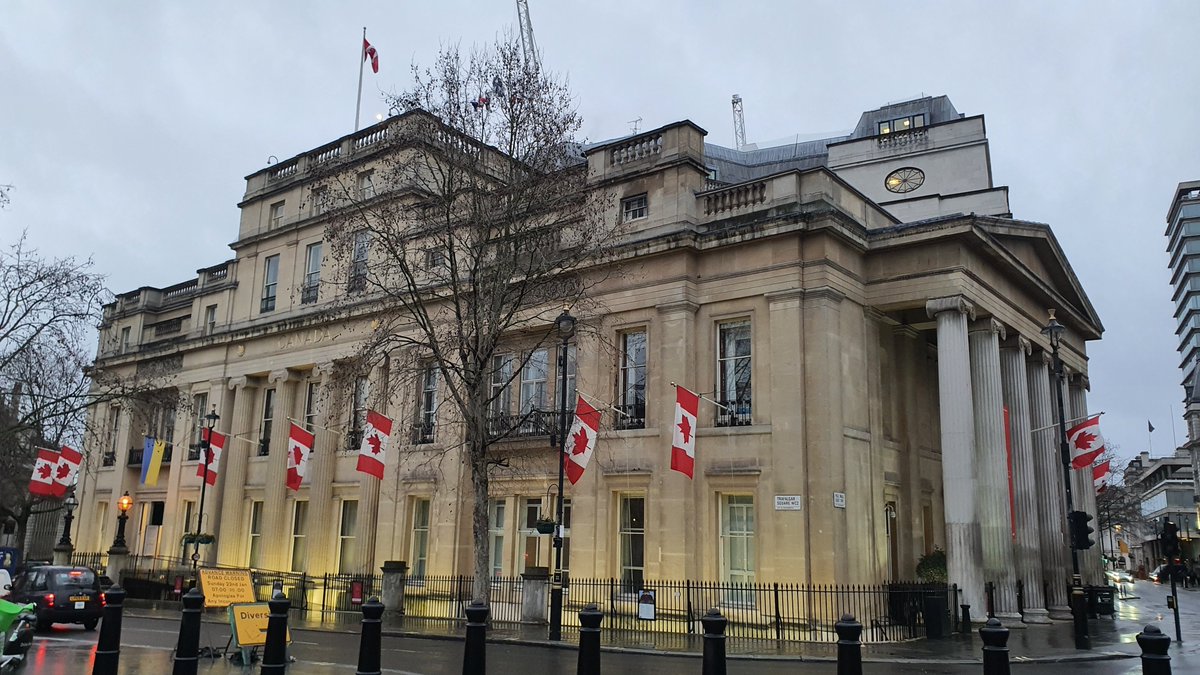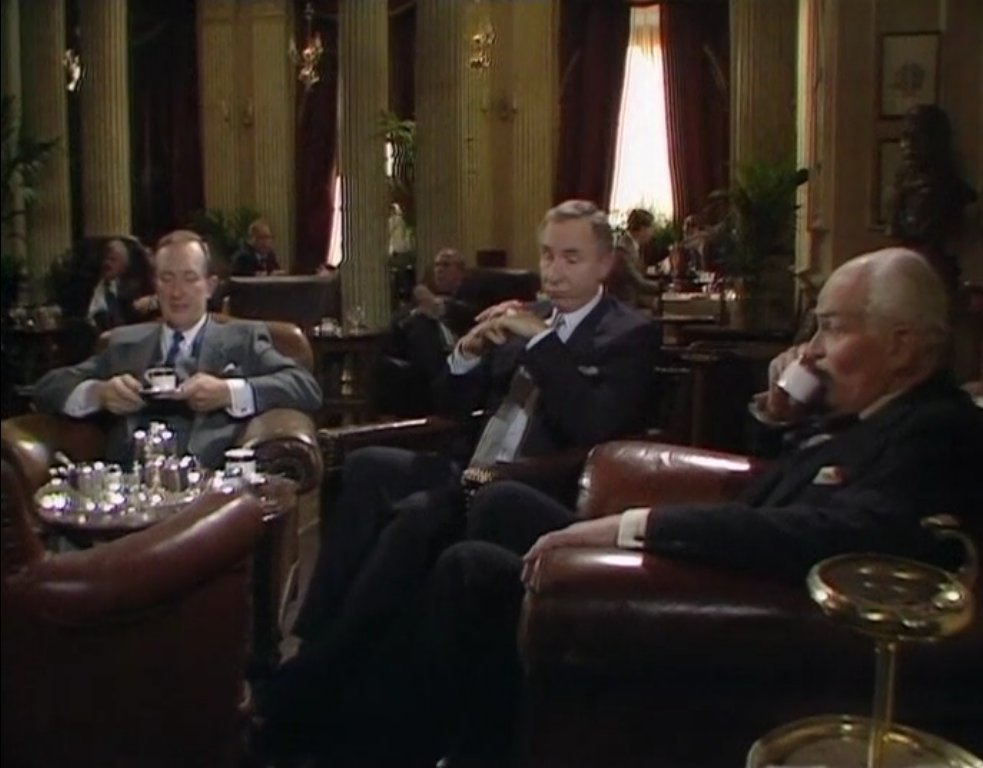On #JamesBondDay, the 60th anniversary of Dr No, I'll be starting another of my "Clubs in film" threads, looking at how clubs have been an essential part of the James Bond films.
Lest you think this is tangential, Dr No literally starts with 3 assassins turning up at a club...
Lest you think this is tangential, Dr No literally starts with 3 assassins turning up at a club...

But before I get too deep into the James Bond movies, it's worth recognising how clubs were an essential backdrop to the Bond books.
M's club, Blade's, recurs in several books (esp. Moonraker), and is clearly based on Fleming's club, Boodle's. (Seen here in the 50s comic strip.)

M's club, Blade's, recurs in several books (esp. Moonraker), and is clearly based on Fleming's club, Boodle's. (Seen here in the 50s comic strip.)


Indeed, readers of my new book may recognise that the front entrance of Boodle's, which inspired the fictional Blade's, was used for the front cover. 



The interior of Blade's was very much as Fleming had known Boodle's since the 1930s: stuffy, staid, full of old duffers snoozing/reading the papers. Newspapers ironed & loose change boiled.
There's a fun account of it (featuring Fleming) in David Niven's The Moon's a Balloon.
There's a fun account of it (featuring Fleming) in David Niven's The Moon's a Balloon.

Fleming's portrayal of Blade's went right back to the Georgian roots of clubs.
Gambling was still heavily regulated in 1950s Britain. Private members' clubs - which, by definition, were not open to the public - offered a rare chance to gamble openly.

Gambling was still heavily regulated in 1950s Britain. Private members' clubs - which, by definition, were not open to the public - offered a rare chance to gamble openly.


And Fleming gave us some world-building in how the credit rules would work in his fictional Blade's club.
Anyway, to the movie Bond, and how clubs appear in the films...
Anyway, to the movie Bond, and how clubs appear in the films...

The fictional Queen's Club in Kingston, Jamaica, seen in Dr No, was closely based (in book & film) on the real-life Liguanea Club - which was also used as the filming location.
These clubs were a major component of British imperial rule - which formed a backdrop to Dr No.

These clubs were a major component of British imperial rule - which formed a backdrop to Dr No.


Remember, when Dr No was filmed, Jamaica was still a British colony, with indepencence on the horizon - it became independent in August 1962, two months before the film's release. 

The colonial world was tiny, both in terms of the small number of white British colonists making up a % of the population; and the physical space they occupied, typically a small part of each town.
The club was a secure compound, with reminders of home - essential to empire.
The club was a secure compound, with reminders of home - essential to empire.

When the film opens, Commander Strangways, Prof Dent & 2 other members have been playing cards on the veranda.
Verandas were common in colonial clubs - Europeans were unaccustomed to tropical climates, so colonial club life revolved around indoor fans & outdoor verandas.
Verandas were common in colonial clubs - Europeans were unaccustomed to tropical climates, so colonial club life revolved around indoor fans & outdoor verandas.

Here you get a better view of the structure of the veranda in front of the Queen's Club/Liguenea Club. 

Prof Dent rings a bell & a waiter appears.
This really is a last gasp of empire - white members & non-white servants would not have attracted comment in a colonial-era club, but very much would have only a short time later.

This really is a last gasp of empire - white members & non-white servants would not have attracted comment in a colonial-era club, but very much would have only a short time later.

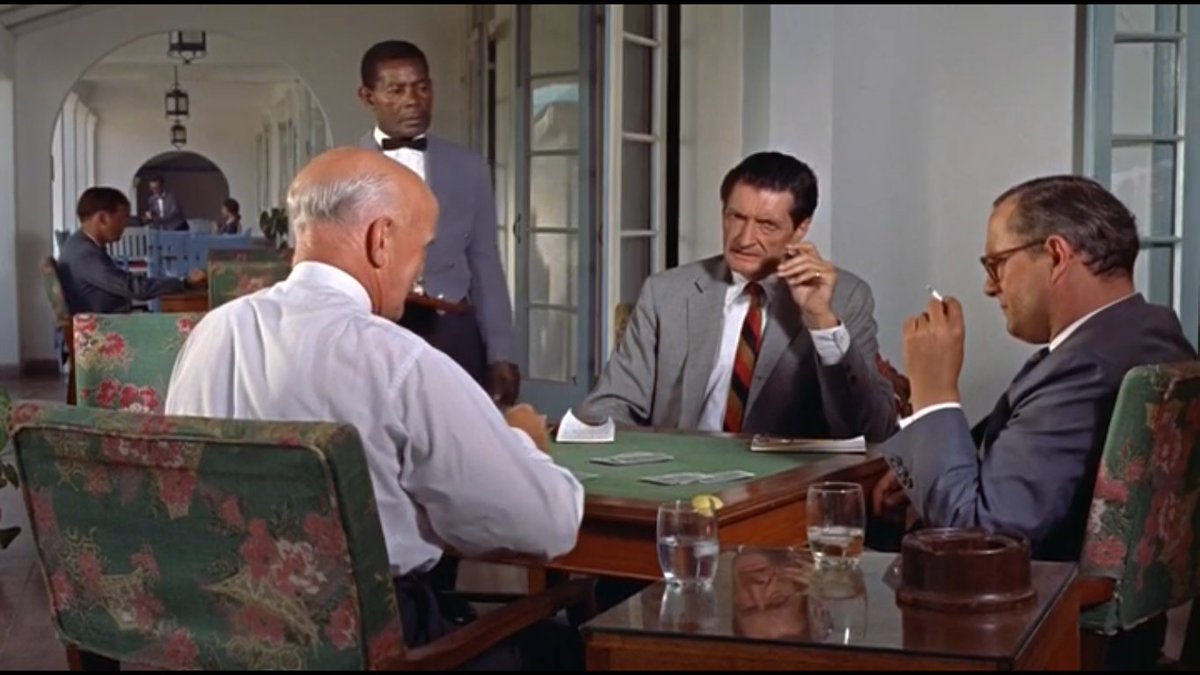
Note the creature comforts on display just in this one shot: card tables, parasols, ashtrays, G&Ts, upholstered chairs. Full-blown colonial luxury.
A lot has been written about Bond being a reaction to the loss of the British Empire. This is literally how the film series starts.
A lot has been written about Bond being a reaction to the loss of the British Empire. This is literally how the film series starts.

Incidentally, the Liguanea Club, which inspired the book setting and was used for the filming, is still going today.
theliguaneaclub.com
theliguaneaclub.com
When Bond wants to quiz Strangways' club acquantances, he says "I want to meet them socially", and is told "I can introduce you at the club tonight."
This happens just indoors from the veranda - note the architecture, to maximise easy ventilation, even indoors.
This happens just indoors from the veranda - note the architecture, to maximise easy ventilation, even indoors.

Then we move onto one of the most iconic scenes in the whole Bond series: our first introduction to James Bond.
This is, of course, set in another private members' club: Les Ambassadeurs.
This is, of course, set in another private members' club: Les Ambassadeurs.

The setting is significant. Like Blade's, this is a gambling club, eagerly able to get around Britain's restrictive gambling laws of the time.
But this is a much chintzier sort of a club. It's not a venerable Georgian institution, but a 1950s pop-up. It says much about Bond.
But this is a much chintzier sort of a club. It's not a venerable Georgian institution, but a 1950s pop-up. It says much about Bond.

Our first introduction to Les Ambassadeurs is on the front entrance. This is much more of a reception than a porter's lodge. For all the old paintings, furniture and panelling, this is a modern club, modelled more on a casino/hotel than a historic club. 

But they're clearly trying very hard to add traditional "high-class" features - note the footman's antiquated livery, already something of a rarity in the clubs of 1960s London. 

This isn't a club which has gambling on the side. Its casino is at the heart of its operation.
This is the kind of club where (unlike the traditional clubs) you have to be rich, but not too many questions are asked about your character, so long as you pay your debts.
This is the kind of club where (unlike the traditional clubs) you have to be rich, but not too many questions are asked about your character, so long as you pay your debts.

There is clearly dining at Les Ambassadeurs, but it's secondary to the business of gambling, which is the main event - diners sit at balconies overlooking the gambling tables.
(Traditional clubs put their dining at the centre & any gambling is done elsewhere, separated off.)
(Traditional clubs put their dining at the centre & any gambling is done elsewhere, separated off.)

Brooks's Subscription Room (seen here in a celebrated print, where the scaling of humans is off - the real room is smaller) is an example of how a 'typical' historic club would have separate rooms for gambling.
(Ironically, it's now mainly used as a dining/events room.)
(Ironically, it's now mainly used as a dining/events room.)
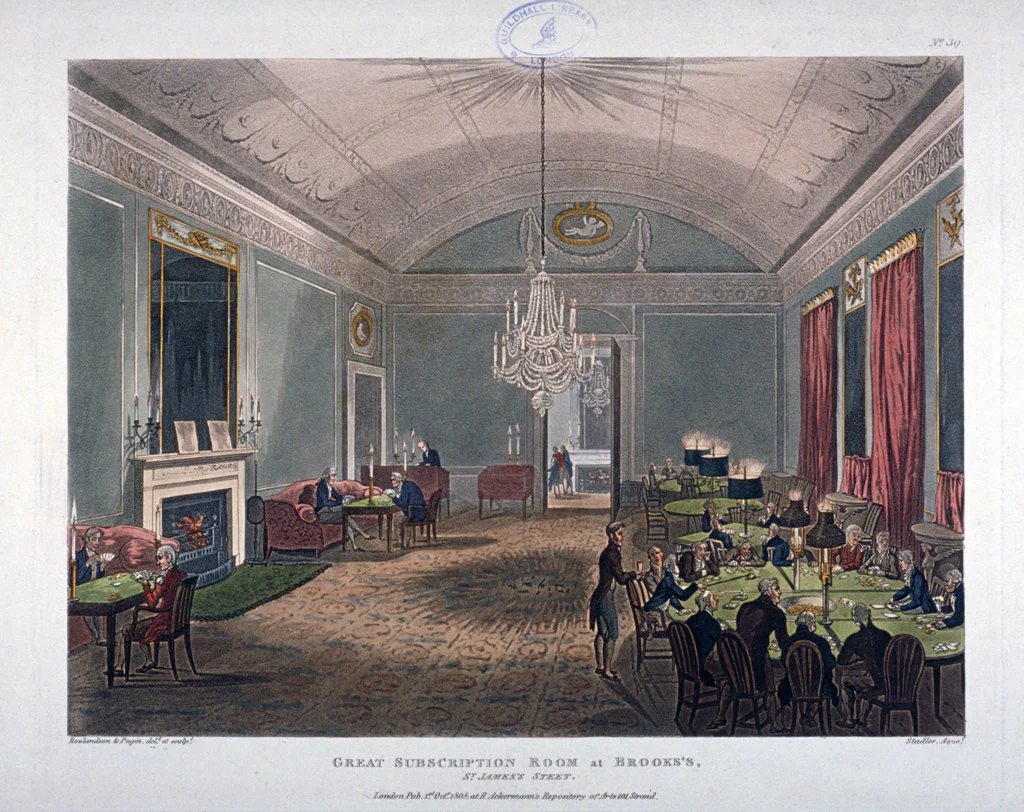
Note also the mixed-sex composition of Les Ambassadeurs club. Clubs were always far more mixed-sex than their image suggests, and Les Ambassadeurs was no exception. 

Moreover, it's clear that the women seen here are club members, not just guests.
How can we be sure?
Because Sylvia Trench is playing cards. Only members could gamble in a private members' club.
How can we be sure?
Because Sylvia Trench is playing cards. Only members could gamble in a private members' club.

There's a lot of dressing to impress in this club, but at different levels of formality.
The women are wearing a combination of cocktail dresses & ball gowns. Some men are in lounge suits (straight from work?), Connery is really showing off with his dinner jacket...
The women are wearing a combination of cocktail dresses & ball gowns. Some men are in lounge suits (straight from work?), Connery is really showing off with his dinner jacket...

Though it now looks rather dated. the shawl collar was super-fashionable on early 60s dinner jackets, while the turned-back silk cuffs were a raffish touch.
The differing levels of formality suggest a "minimum standard" of dress in this club, rather than prescriptive dress code.
The differing levels of formality suggest a "minimum standard" of dress in this club, rather than prescriptive dress code.

Moreover, the differences in dress probably suggest that this was combined with other recreations - you might drop into this gambling club before/after the opera, or a Michelin-starred restaurant. They would have had more prescriptive dress requirements than the Club. 

Overall, Les Ambassadeurs club in the film is quite a flashy, garish sort of place, where members flash their cash (quite literally in the case of Bond).
It was upmarket, in a "vulgar new money" kind of way - which really said a lot about Bond, in his first appearance.

It was upmarket, in a "vulgar new money" kind of way - which really said a lot about Bond, in his first appearance.


The real-life club it was probably closest to was the Clermont Club, founded by John Aspinall on Berkeley Square earlier that year (1962).
It mixed "old" & "new" money, had grand surroundings & was the place to be seen (even if Aspinall fixed the gaming tables). It's in my book!
It mixed "old" & "new" money, had grand surroundings & was the place to be seen (even if Aspinall fixed the gaming tables). It's in my book!

While Les Ambassadeurs, as seen in the film, was a studio set, there is a Mayfair casino of that name, based on its ambience. It's been through several owners & changes of location, as the London casinos have had varying fortunes, but still exists today. lesambassadeurs.com
In a slight digression (I'll move onto Goldfinger tomorrow) Omar Sharif memorably had an excuse for why he didn't have a gambling problem. He said casinos were the only place he could dine alone without inviting comment.
Serious point: casino restaurants are not sociable places.
Serious point: casino restaurants are not sociable places.

Today, I'm looking at Stoke Park, the Buckinghamshire country club used for the round of golf between Bond & Goldfinger.
A country club is a US innovation - with a strong influence from the Indian gymkhana clubs - and Stoke Park was the first country club in the UK, in 1908.
A country club is a US innovation - with a strong influence from the Indian gymkhana clubs - and Stoke Park was the first country club in the UK, in 1908.

Stoke Park forms the backdrop to Bond & Goldfinger's game.
The 19th century saw sports - including golf, cricket & football - grow in popularity by forming organisations modelled around a London club. This included the notion of membership & election with "blackballing".
The 19th century saw sports - including golf, cricket & football - grow in popularity by forming organisations modelled around a London club. This included the notion of membership & election with "blackballing".

This "club" organisation, between established members who'd been vouched for by other members, the trappings of gentility (in theory, at least).
It provides the context for Bond & Goldfinger's first meeting. This is not the no-holds-barred competition of a pay-as-you-go casino.
It provides the context for Bond & Goldfinger's first meeting. This is not the no-holds-barred competition of a pay-as-you-go casino.

Yet from the outset, Bond & Goldfinger each put each other off their game, as the other is about to hit the ball - Bond by dropping a huge bar of Nazi gold in front of Goldfinger, Goldfinger by asking "Straight rules of golf?" just as Bond strikes.
Neither plays fair.
Neither plays fair.

Indeed, the whole meeting shows how perceptive & well-informed Goldfinger is.
Long before he says that it's the second time they've met, Goldfinger meaningfully leans over to suggest, "This meeting is not a coincidence, eh?"
Long before he says that it's the second time they've met, Goldfinger meaningfully leans over to suggest, "This meeting is not a coincidence, eh?"

"Let's have a little fun with Mr Goldfinger": after it's apparent to Bond that Goldfinger is cheating, Bond switches his Slazenger 1 ball with a Slazenger 7 he found.
Cheating scandals in sports clubs still had the powr to be cause célèbres at the time. Bond is no gentleman.
Cheating scandals in sports clubs still had the powr to be cause célèbres at the time. Bond is no gentleman.

You get a real sense of Stoke Park as a working country club, with the external cottage away from the main manson that's used for golf clubs, storage, etc, and is shown inside & out. 







Though closer up, the main house was looking distinctly tatty & in poor repair in 1964 - it looks in much better condition these days! (Though currently closed for renovation, reopening in 2023.) 

After Bond succesfully out-cheats Goldfinger, Oddjob menacingly does his party piece, with what looks like an obvious polystyrene statue added to the grounds for these shots. 







Bond: "Remarkable. But what does the Club Secretary have to say?"
Goldfinger: "Oh, nothing, Mr Bond. I own the Club."
This is a proprietary club, not a members-owned club. Like the earliest clubs of the 18th century (& some of the fashionable new ones today), it has an owner.
Goldfinger: "Oh, nothing, Mr Bond. I own the Club."
This is a proprietary club, not a members-owned club. Like the earliest clubs of the 18th century (& some of the fashionable new ones today), it has an owner.

"I assume you want the cheque made out to cash?" Goldfinger shows that even though he smells a rat, he still goes through the formality of paying his debts from the golf wager.
In this way, he shows he's probably less of an absolute rotter than Bond.
In this way, he shows he's probably less of an absolute rotter than Bond.
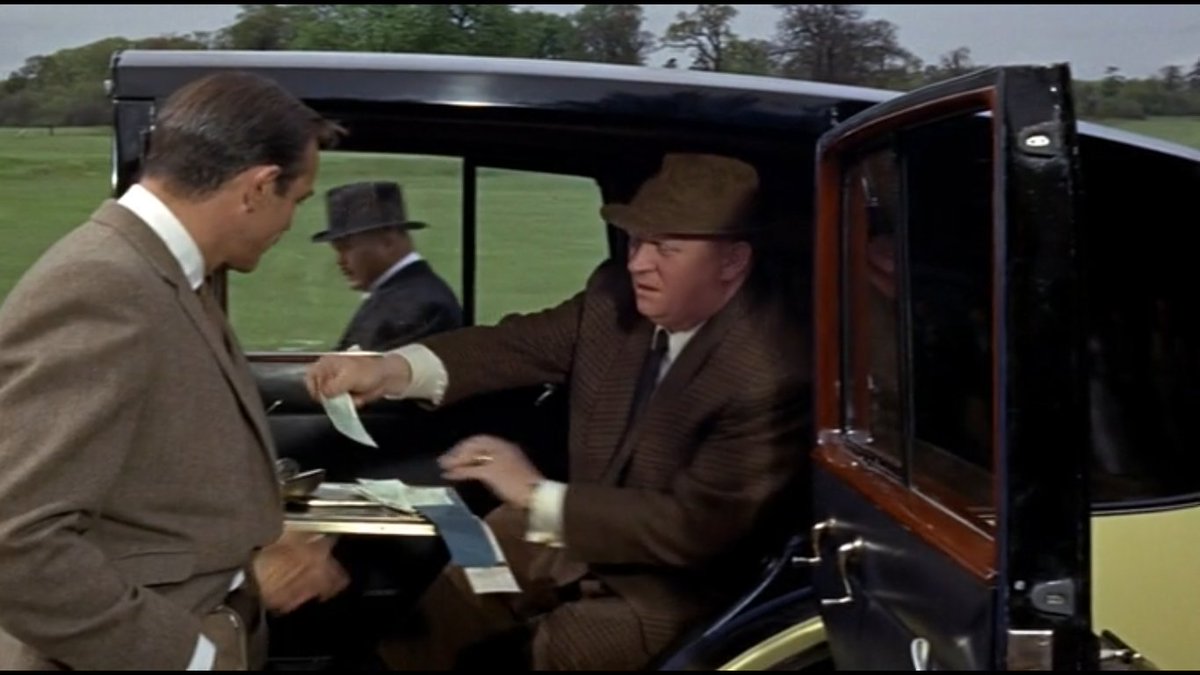
And just so there's no doubt as to where this is set, Bond's homing device shows a clearly-labelled "Stoke Park".
This isn't some fictitious Auric Goldfinger country club which happens to have used Stoke Park as a location. It's explicitly supposed to be Stoke Park in the film.
This isn't some fictitious Auric Goldfinger country club which happens to have used Stoke Park as a location. It's explicitly supposed to be Stoke Park in the film.

Stoke Park today makes much of its Bond history, with plenty of conventions, etc.
There's still a country club on the estate, and "In April 2021, Stoke Park welcomed its fifth owners since 1908" - they're currently giving it a major renovation.
stokepark.com
There's still a country club on the estate, and "In April 2021, Stoke Park welcomed its fifth owners since 1908" - they're currently giving it a major renovation.
stokepark.com
Looks like I spoke too soon about Stoke Park. It’s always looked glamorous in recent photos.
But the website says they have “legionella, leaking roof & cracks, wall movement…[course] lacks suitable drainage & irrigation technology leading to flooding & regular course closures”!
But the website says they have “legionella, leaking roof & cracks, wall movement…[course] lacks suitable drainage & irrigation technology leading to flooding & regular course closures”!
Next, we see a private members' club in a non-Eon James Bond film: the 1967 spoof version of Casino Royale.
These scenes were shot for the original version of the film - before Peter Sellers stormed off, leaving scenes unfinished (which is why the film makes no narative sense.)
These scenes were shot for the original version of the film - before Peter Sellers stormed off, leaving scenes unfinished (which is why the film makes no narative sense.)

Sellers, who by all accounts let the role go to his head, tried to suppress the humour & play the Bond character 'straight' in his scenes.
So this scene is actually quite good at capturing the atmosphere of Fleming's novel, & the feel of a seedy Bayswater basement gambling club.
So this scene is actually quite good at capturing the atmosphere of Fleming's novel, & the feel of a seedy Bayswater basement gambling club.

Of course, Sellers isn't playing Bond, but a Bond surrogate named Evelyn Tremble - a baccarat expert (& paperback writer) who's drafted in to assume the Bond identity, to take on Le Chiffre at Casino Royale, for...reasons never entirely plausible in any version of the script. 

David Niven's post-production voiceover tells us that Tremble is "a man who works at the Buckingham Club."
The visual hint is that Tremble is supplementing his modest income in this seedy gambling club, by working the fruit machines with his own system.
The visual hint is that Tremble is supplementing his modest income in this seedy gambling club, by working the fruit machines with his own system.

Unlike most of the private members' clubs seen in the Eon Bond films so far, the Buckingham Club is not a classy establishment.
It's more a foreshadowing of Q rigging the Las Vegas fruit machines in Diamonds Are Forever (1971) - but for markedly lower stakes: this is a dive.

It's more a foreshadowing of Q rigging the Las Vegas fruit machines in Diamonds Are Forever (1971) - but for markedly lower stakes: this is a dive.


Into this scene walks Ursula Andress as Vesper Lynd.
From the looks she draws, from men & women alike, it's apparent that the Buckingham Club is unaccustomed to visitors in such sumptuous dresses.
From the looks she draws, from men & women alike, it's apparent that the Buckingham Club is unaccustomed to visitors in such sumptuous dresses.

Andress' Vesper Lynd makes a beeline for Sellers' Evelyn Tremble. She's there to seduce him & rope him into the British secret service's scheme. 

It doesn't take her long. Tremble - a meek man, clearly more at ease working out numerical systems for winning games of chance - doesn't seem particularly used to attention or affection. He's quite the contrast to Bond. 

And Tremble is clearly overwhelmed, having just had this glamorous stranger suggest he join her in her bed, and that her car is being sent over for him.
This is so very different to the tedious, predictable, low-stakes gambling world he usually occupies in the Buckingham Club.
This is so very different to the tedious, predictable, low-stakes gambling world he usually occupies in the Buckingham Club.

And the glamorous Vesper Lynd wanders off, still very much out of place here.
Indeed, when Tremble first enters the sumptuous Casino Royale much later in the film, he's visibly stunned, and says "It's just a bit different from the Buckingham Club, that's all."
Indeed, when Tremble first enters the sumptuous Casino Royale much later in the film, he's visibly stunned, and says "It's just a bit different from the Buckingham Club, that's all."

Incidentally, I've had DMs asking me why I'm not covering the casinos also seen in Bond films (pictured).
These weren't private members' clubs - they were open to all with £££. Fleming, an avid clubgoer, made private clubs a part of Bond's world; & this thread focuses on those.


These weren't private members' clubs - they were open to all with £££. Fleming, an avid clubgoer, made private clubs a part of Bond's world; & this thread focuses on those.



It's then a whole decade before we see a private members' club in another James Bond film - the fictional Mojaba Club of Cairo, in The Spy Who Loved Me (1977).
While it's onscreen for barely five minutes, we actually see a fair bit of it, internally and externally.
While it's onscreen for barely five minutes, we actually see a fair bit of it, internally and externally.

Some guidebooks suggest this is just a nightclub, but there are several architectural clues that this is a private members' club - most notably the high walls around the expansive premises, for keeping people out. This is a traditional, colonial-style gymkhana club. 



And as with many of these colonial-era clubs, it has a complex of large outhouses dotted around the main building, which are briefly seen when Bond pursues Jaws. 

Internally, the set revolves around a central atrium with strong Islamic architectural influences, through which all the other rooms are reached.
The interior (a studio set) is very different to the barely-glimpsed British imperial-style exterior.
The interior (a studio set) is very different to the barely-glimpsed British imperial-style exterior.

To one side of the atrium is the main bar, in a very contemporary 1970s style, but again, with the more traditional Islamic touches of the courtyard evident. 







To another side of the courtyard are the phone booths lined up in cubicles - it's here that Jaws silently murders Max Kalba. 





The busiest section of the Mojaba Club has a stage with entertainments. It's this part of the set which leads to the widespread belief that it must just be a nightclub.
But the ambience & architecture of the Club suggests otherwise, and it's not unusual to have stages like this.



But the ambience & architecture of the Club suggests otherwise, and it's not unusual to have stages like this.




It's at a balcony area to the side of this stage that Bond & Major Amasova meet Max Kalba, described as "the owner of the Club" - so it's established as a proprietary club, not a member-owned one.
It's a conversation cut short by Kalba's phone call, resulting in his murder.

It's a conversation cut short by Kalba's phone call, resulting in his murder.


The Mojaba Club is little-remembered in Bond canon, being mainly a bridging link from the last setpiece fight to the next.
Even Marvin Hamlisch, the film's composer, wasn't overly familiar with it - his score had a track called "Mojave Club". Presumably he wasn't given a script.
Even Marvin Hamlisch, the film's composer, wasn't overly familiar with it - his score had a track called "Mojave Club". Presumably he wasn't given a script.

Having been a major ingredient of the novels & 60s films, clubs then mostly vanish in the remaining 70s & 80s Bond films, apart from a couple of passing references...
In the non-Eon 'Never Say Never Again' (1983), Bond & Domino smile in bemusement when at the end of the mission, Edward Fox's phlegmatic & formal 'M' says over the radio to Bond, "I'd like to offer you lunch at my club."
They are worlds apart.
They are worlds apart.

And in 'Licence to Kill' (1989), when Timothy Dalton's Bond confronts Robert Brown's 'M' at the Hemingway House in Cuba, he tenders his resignation from the secret service.
'M' is unimpressed by such histrionics, telling Bond: "We're not a country club."

'M' is unimpressed by such histrionics, telling Bond: "We're not a country club."


Today I'll be looking at the Pierce Brosnan era of Bond.
No clubs in Tomorrow Never Dies (1997), but it's worth pointing out that we return to Stoke Park - last seen as the golf club in Goldfinger (1964) - and used as a filming location for the interiors of the Hamburg hotel...



No clubs in Tomorrow Never Dies (1997), but it's worth pointing out that we return to Stoke Park - last seen as the golf club in Goldfinger (1964) - and used as a filming location for the interiors of the Hamburg hotel...




Die Another Day (2002) has two clubs portrayed.
Firstly, there is the fictional Yacht Club Hong Kong, to which Bond escapes from British custody aboard a destroyer moored in the harbour, after 14 months of torture in North Korea.
Firstly, there is the fictional Yacht Club Hong Kong, to which Bond escapes from British custody aboard a destroyer moored in the harbour, after 14 months of torture in North Korea.
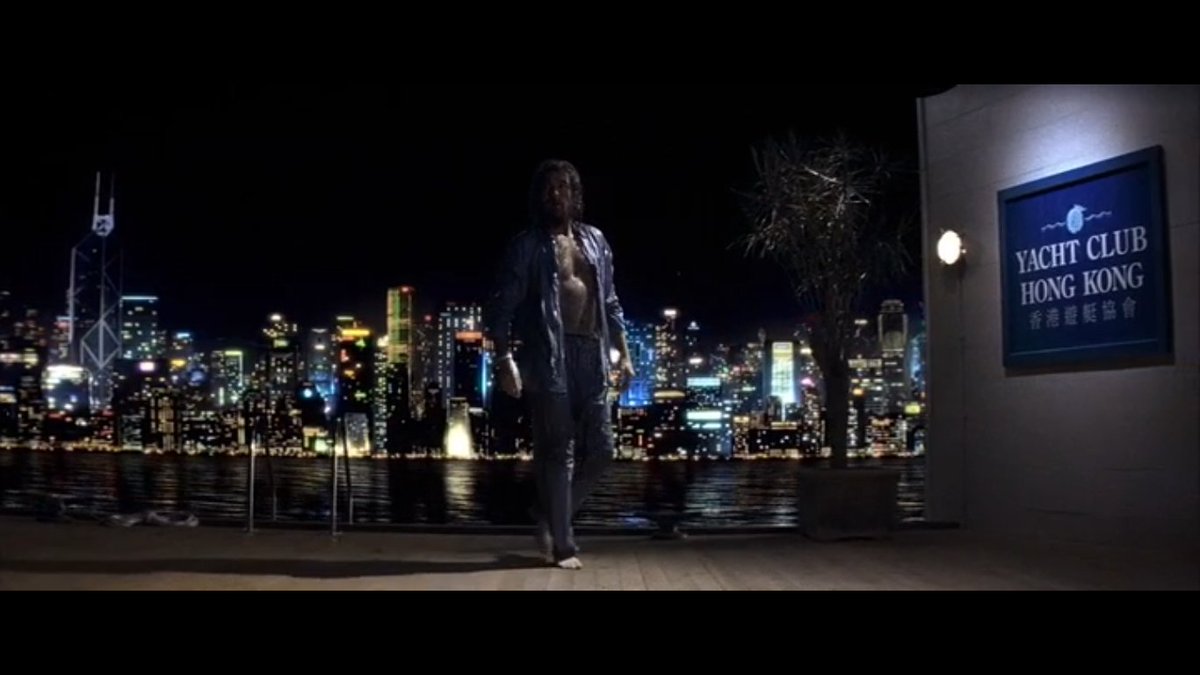
Hong Kong has dozens of clubs, mostly sports-themed (including assorted cricket, football & golf clubs), with many dating to British imperial rule.
None is precisely called the Yacht Club Hong Kong, though there's no shortage of yacht clubs there...
None is precisely called the Yacht Club Hong Kong, though there's no shortage of yacht clubs there...

The nearest match is the historic Royal Hong Kong Yacht Club, founded in 1890 & still going strong - which wasn't named in the film, presumably for copyright reasons.
rhkyc.org.hk
rhkyc.org.hk
However, there are further clues in the next scene that this is a different kind of establishment to the Royal Hong Kong Yacht Club.
At first glance, this is a luxury hotel, called the Rubeyon Royale Hotel, to which a bearded Bond strides in, still in his soaking pyjamas...

At first glance, this is a luxury hotel, called the Rubeyon Royale Hotel, to which a bearded Bond strides in, still in his soaking pyjamas...


But the disgusted expressions of members murmurring "No tie!" to Bond suggests this is a continuation of the last scene - that it's a modern private members' club, operating its own connected but separate hotel; a common business model across Asia & North America. 

Bond asks for "My usual suite, please", but initially gets short shrift from the receptionist, who takes one look at him and sneers: "Do you have a credit card? Or even any luggage, sir?" This is not welcoming behaviour. 



Fortunately, even with his beard, Bond is recognised by the passing concierge, Mr Chang:
"Mr Bond! So good to see you. It's been a long time." He orders the Presidential Suite to be put at Bond's disposal.
"Mr Bond! So good to see you. It's been a long time." He orders the Presidential Suite to be put at Bond's disposal.

Bond has his tailor sent for, with some food.
Chang recommends the lobster with quail's eggs & sliced seaweed - a feast fit for anyone just out of prison. Bond asks for the '61 Bollinger to be thrown in.
"Been busy, have we, Mr Bond?"
"Just surviving, Mr Chang. Just surviving."

Chang recommends the lobster with quail's eggs & sliced seaweed - a feast fit for anyone just out of prison. Bond asks for the '61 Bollinger to be thrown in.
"Been busy, have we, Mr Bond?"
"Just surviving, Mr Chang. Just surviving."


The suite is spacious (especially by Hong Kong standards, given space is at a premium!) & luxurious, if impersonal.
The various goods are promptly delivered up, and a now-shaved Bond starts to look himself again.



The various goods are promptly delivered up, and a now-shaved Bond starts to look himself again.




When an attractive masseuse shows up, he smells a rat, rapidly pulls a gun from her garter holster, and flings an ashtray at the bedroom mirror, shattering it... 







Behind the bedroom's two-way mirror is Mr Chang with a camera crew, focused on the bed.
It's a classic Kompromat setup, of the kind long since made famous by the Donald Trump pee-pee tape allegations. But real-life spies have been setting people up like this for decades.
It's a classic Kompromat setup, of the kind long since made famous by the Donald Trump pee-pee tape allegations. But real-life spies have been setting people up like this for decades.

Bond: "You think I haven't always known you were Chinese intelligence, Chang?"
Chang protests: "Hong Kong's our turf now, Bond."
Still topical.
Chang protests: "Hong Kong's our turf now, Bond."
Still topical.

Bond cuts a deal with Chang, seeking his help to get even with their mutual enemy, Zao.
"I'll have to ask Beijing", Chang responds.

"I'll have to ask Beijing", Chang responds.


Later, Chang gives Bond a small chest, as "A little 'thank you' from us" - it's a passport, and a ticket to Cuba.
He's off on his mission; the club has performed its role in the plot, sending him on his way.

He's off on his mission; the club has performed its role in the plot, sending him on his way.


For the second club in Die Another Day (2002)...
After 40 years & 20 Bond films, we finally get a portrayal of Blade's club, which was frequently mentioned in the books.
After 40 years & 20 Bond films, we finally get a portrayal of Blade's club, which was frequently mentioned in the books.

It's not much like the staid, stuffy Blade's depicted in the books, which was a standard London dining club. Here, they've extrapolated the name to be a fencing-themed club.
But the film set is EXTREMELY interesting, with real research & attention to detail. I'll explain why...
But the film set is EXTREMELY interesting, with real research & attention to detail. I'll explain why...

The Blade's clubroom seen in the film (the fencing set) is modelled on the decor of the Reform Club.
That's because they actually film in the real Reform Club for part of the swordfight, & want to make the transition between set & club as seamless as possible.
That's because they actually film in the real Reform Club for part of the swordfight, & want to make the transition between set & club as seamless as possible.

But they also wanted to have the scope for the dramatic swordfight to break out into an outdoor courtyard.
The real Reform Club doesn't have an external courtyard like this, just a garden overlooking houses across the rear street - hence the set/location shoot hybrid.
The real Reform Club doesn't have an external courtyard like this, just a garden overlooking houses across the rear street - hence the set/location shoot hybrid.

Look at that frieze, high on the wall of the Blade's set.
It's very closely modelled on the real-life classical friezes embedded into Charles Barry's Reform Club rooms, repeated throughout the building.
See the example of the frieze on the right, above the bookcases.

It's very closely modelled on the real-life classical friezes embedded into Charles Barry's Reform Club rooms, repeated throughout the building.
See the example of the frieze on the right, above the bookcases.


Those pillars on the studio set are perfectly in proportion (and perfectly-coloured in the right shade of gold) to match the identical pillars that recur through the real-life Reform Club building (seen, for instance, in the library on the right). 



Those windows on the set are a perfect match for the dimensions of those in the real-life Reform Club.
This is attention to detail above & beyond the call of duty - while there will be matching of shots with club interiors, we don't see any Reform Club windows in the film.
This is attention to detail above & beyond the call of duty - while there will be matching of shots with club interiors, we don't see any Reform Club windows in the film.

Even the painted wooden panelling around the windows is exceptionally accurate, closing matching that found in the Reform Club's coffee room, overlooking the back garden. 



And the doorways are spot-on - the triangle over the threshold, seen in the centre, is a perfect match. 

Where it takes some licence is with artwork, which is 'generically classical', or else has weapons on display. The real-life Reform Club is a memorial to 19thC Whig politicians.
But I'll grant them some leeway - this is not meant to be a political club, but a sword-themed one.
But I'll grant them some leeway - this is not meant to be a political club, but a sword-themed one.

The display cases monopolising the middle of the room are going a bit far, though. It makes for a dramatic shattering of glass & a suit of armour later on in the scene, but no club has this - display cases are always on the side.
Clubs are places of leisure, not museums.
Clubs are places of leisure, not museums.

Anyway, the profusion of weaponry means that when Gustav Graves ups the stakes in his swordfight with Bond, he ditches his foil and seizes two sabres that are mounted on the wall. 

...And then we're off into the real Reform Club, where the swordfight seamlessly breaks, making use of the first-floor gallery overlooking the saloon. 

Although you the lack of attention to detail in authentic artwork, when Graves tears a painting.
This is a generic picture of a 17th century aristocrat, inserted for the tearing stunt.
The Reform has no pictures like this - contrast to real 19thC paintings a few seconds later.

This is a generic picture of a 17th century aristocrat, inserted for the tearing stunt.
The Reform has no pictures like this - contrast to real 19thC paintings a few seconds later.


One further critcism: the scene transfer back, from the real Reform Club, to the set.
This doesn't match, if you look at the green doorway. The first transition was much better done with an edit, rather than the camera capturing a poor studio likeness through the door.

This doesn't match, if you look at the green doorway. The first transition was much better done with an edit, rather than the camera capturing a poor studio likeness through the door.


Then after passing through the interior set again, they have some real fun shattering glass & ending up in the courtyard, going up & down steps.
This, I suspect, is why they used a film set for this bit, rather than just location shoots at the Reform Club for the whole thing.



This, I suspect, is why they used a film set for this bit, rather than just location shoots at the Reform Club for the whole thing.




The steps are interesting. It doesn't match any club, but it's not dissimilar to the (modern) steps put in to give garden access to Charles Barry's Travellers Club building, next door to the Reform Club. 

Again, something I admire about the reseach here is the dimensions of the windows on the studio set, seen here from outside.
There was no need to match the Reform Club so closely (we only see its windowless inner gallery), but the designers have done a great job here.

There was no need to match the Reform Club so closely (we only see its windowless inner gallery), but the designers have done a great job here.


"Settle downstairs, shall we?" suggests Graves. The club setting still demands that honour is satisfied, as they conclude their wager which prompted the swordfight. 

Replacement paintings, to substitute the damage, start being hauled across the saloon of the Reform Club/Blade's... 

• • •
Missing some Tweet in this thread? You can try to
force a refresh








